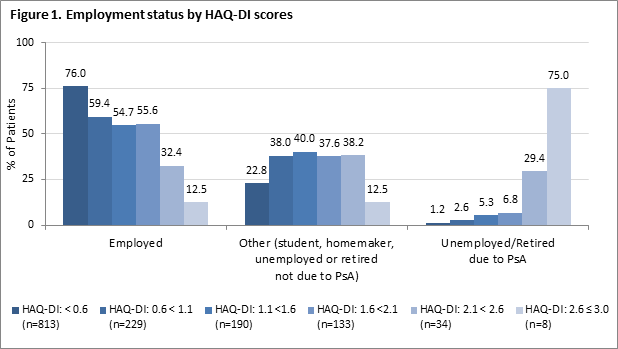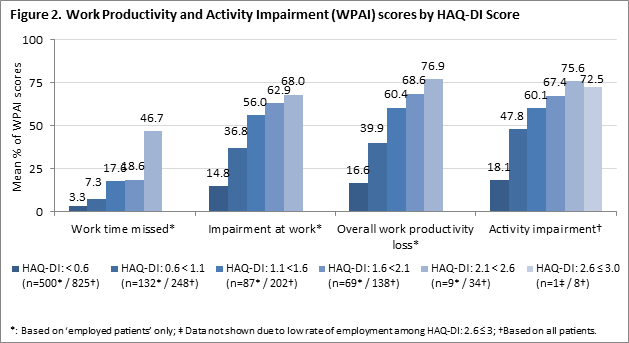Session Information
Session Type: ACR Poster Session B
Session Time: 9:00AM-11:00AM
Background/Purpose:
Methods: Data were drawn from an international study of rheumatologists and dermatologists, and their PsA patients across 11 countries (USA, EU, Turkey, Japan, South East Asia, Mexico, Australia and Middle East). Physicians provided diagnosis and patient demographics and their perception of PsA severity, recorded as mild, moderate or severe. Patients reported their employment status, completed the Health Assessment Questionnaire Disability Index (HAQ-DI), and Work Productivity & Activity Impairment questionnaire (WPAI). HAQ-DI scores were compared by physician reported PsA severity. Patients were stratified by their HAQ-DI score into six subgroups (<0.6; 0.6 <1.1; 1.1<1.6; 1.6 <2.1; 2.1 < 2.6; 2.6
Results: 1499 patients of working age with a mean age of 44.75yrs (SD 10.15) were analyzed. Patient physical functioning decreased with more severe PsA (HAQ-DI Mean (SD): mild, 0.46 (0.60); moderate, 0.87 (0.69); severe, 1.09 (0.69); p<0.0001). HAQ-DI sub-group analysis demonstrated significant differences in employment status with employment decreasing as HAQ-DI score increased, and the rate of unemployment or retirement due to PsA increasing as HAQ-DI increased (p<0.0001) (Figure 1). In employed patients, the percentage of work time missed due to PsA significantly increased as HAQ-DI score increased (Figure 2), as did percentage of impairment while working, and overall work impairment. Among employed and unemployed patients a similar relationship was seen for percentage of activity impairment. All HAQ-DI and WPAI relationships were significant in the overall sample, and on a regional level, categorized as the USA, the 5EU countries, and the rest of world (p <0.0001).
Conclusion: This analysis confirms a strong inverse relationship between physical functioning, employment levels and work productivity in PsA patients. This suggests that strategies to reduce disability in PsA will not only benefit patients but will also have a beneficial societal and economic impact.
To cite this abstract in AMA style:
Conaghan PG, Alten R, Strand V, Deodhar AA, Sullivan E, Blackburn S, Tian H, Gandhi K, Jugl S. The Relationship Between Physical Functioning and Work for People with Psoriatic Arthritis: Results from a Large Real-World Study in 16 Countries [abstract]. Arthritis Rheumatol. 2016; 68 (suppl 10). https://acrabstracts.org/abstract/the-relationship-between-physical-functioning-and-work-for-people-with-psoriatic-arthritis-results-from-a-large-real-world-study-in-16-countries/. Accessed .« Back to 2016 ACR/ARHP Annual Meeting
ACR Meeting Abstracts - https://acrabstracts.org/abstract/the-relationship-between-physical-functioning-and-work-for-people-with-psoriatic-arthritis-results-from-a-large-real-world-study-in-16-countries/


